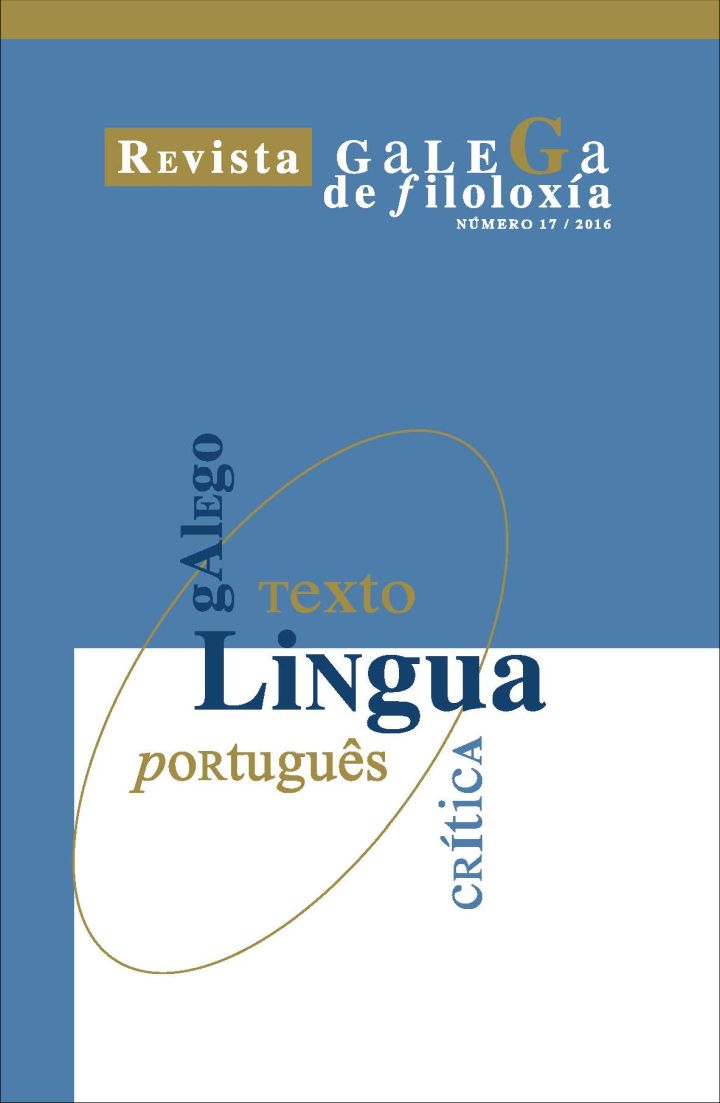aaBBB: A forma estrófica da cantiga 7 de Fernan Rodriguez de Calheiros
Contido principal do artigo
Resumo
O refrán da cantiga de amigo de Fernan Rodriguez Calheiros (B 632/V 233), até agora mal entendido como un conxunto de cinco versos, debe tomarse como un estribillo de 3 versos con dúas rimas internas no verso medio, segundo a forma estrófica aaBBB. Esta análise fica confirmada por dúas técnicas especiais: o verso medio do refrán BBB mide máis do que os exteriores, mais correspóndese cos versos do dístico, e o texto constitúe un exemplo de refrán BBB onde o terceiro verso repite o primeiro.
Palabras clave:
Descargas
Métricas
Detalles do artigo
Citas
B = Biblioteca Nacional (Lisbon), cod. 10991.
V = Biblioteca Apostolica Vaticana (Rome), cod. lat. 4803.
Braga, Theophilo (1878). Cancioneiro portuguez da Vaticana. Lisbon: Imprensa Nacional.
CA = Carolina Michaëlis de Vasconellos, Cancioneiro da Ajuda. 2 Vols. Halle: Max Niemeyer, 1904.
CEM = Manuel Rodrigues Lapa, Cantigas d’escarnho e de mal dizer dos cancioneiros medievais galego-portugueses (2nd ed.). Vigo: Galaxia, 1970.
Cohen, Rip (1996). “Dança Jurídica”. Colóquio-Letras, 142, 5-49.
Cohen, Rip (2003). 500 Cantigas d’ Amigo. Porto: Campo das Letras.
Cohen, Rip (2005). “In the Beginning was the Strophe: Origins of the Cantiga d’Amigo Revealed!” Modelo: Actas do X Colóquio da Secção Portuguesa da Associação Hispánica de Literatura Medieval. Ed. Ana Sofia Laranjinha and José Carlos Miranda. Porto: Faculdade de Letras da Universidade do Porto. 243-255.
Cohen, Rip (2009). “Technical Virtuosity in the Cantigas d’Amigo”. Floema: Caderno de Teoria e História Literária 5, 125-144. Web.
Cohen, Rip (2010a). “Cantar Igual: External Responsion and Textual Criticism in the Galician-Portuguese Lyric”. La Corónica. A Journal of Medieval Hispanic Languages, Literatures and Cultures, 38.2, 5-25.
Cohen, Rip (2010b). “Colometry and Internal Rhyme in Vidal, Judeu d’Elvas”. Ars Metrica. Web.
Cohen, Rip 2010c). “A Formal Approach to Cantiga Sequences”. Ars Metrica. Web.
Cohen, Rip (2011). “From Folksong to Lyric Theater: The Evolution of the Cantigas d’Amigo”. En: Manuel Calderón, José Camões and José Pedro Sousa (org.), Por s’ Entender Bem a Letra. Homenagem a Stephen Reckert. Lisbon: Imprensa Nacional-Casa da Moeda. 637-663.
Cohen, Rip (2012). “Two Corrections to the Text of the Cantigas d’Amigo”. eHumanista. Journal of Iberian Studies, 22, 1-26. Web.
Cohen, Rip (2013a). “The Geometry of Rhetoric and Action”. Washington DC: Virtual Center for the Study of Galician-Portuguese Lyric. Web.
Cohen, Rip (2013b). “Cantigas d’Amigo with aaB Forms by Galician Jograres”. Washington DC: Virtual Center for the Study of Galician-Portuguese Lyric. Web.
Cohen, Rip (2013c). aaB: Strophic Form and Cognition”. Cognitive Philology 6. Web.
Cohen, Rip (2014a). “Internal Rhyme and the History of Strophic Song”. Washington DC: Virtual Center for the Study of Galician-Portuguese Lyric. Web.
Cohen, Rip (2014b). The Cantigas of Pero Meogo, Edited with Introduction and Commentary. Washington DC: Virtual Center for the Study of Galician-Portuguese Lyric. Web.
Cohen, Rip (2015). “Spatial Deixis and the Origins of the Cantigas d’amigo: Philological Method vs. The School”. Paper posted on academia.edu
Cohen, Rip (2016) (Forthcoming). The Magic of aaB: Form, Rhetoric and Action in the Cantigas d’amigo. Washington DC: Virtual Center for the Study of Galician-Portuguese Lyric. Web.
Corriente, Federico (2009). “The Kharjas: An Updated Survey of Theories, Texts and their Interpretation”. Romance Philology, 63.1, 109-129.
Fabb, Nigel (2014). “The verse-line as a whole unit in working memory, ease of processing, and the aesthetic effects of form”. Royal Institute of Philosophy Supplement, 75, 29-50.
Ferreira, Manuel Pedro. 2005. Cantus Coronatus: 7 Cantigas d’El Rei Dom Dinis. Kassel: Reichenberger.
Gonçalves, Elsa (1993). “Tradição manuscrita da poesia lírica”. Dicionário da literatura medieval galega e portuguesa. Giulia Lanciani and Giuseppe Tavani (coord.). Lisbon: Caminho. 627-632.
MedDB = Base de datos da Lírica Profana Galego-Portuguesa (MedDB). Versión 3.0. Santiago de Compostela: Centro Ramón Piñeiro para a Investigación en Humanidades. http://www.cirp.gal/meddb [Consulted on 2 August 2016].
Monaci, Ernesto (1875a). Il canzoniere portoghese della Biblioteca Vaticana. Halle: Max Niemeyer.
Monaci, Ernesto (1875b). Cantos de ledino tratti dal grande canzoniere portoghese della Biblioteca Vaticana. Halle: Tip. d’Ehrh. Karras. 2nd ed.
Nunes, José Joaquim (1926-1928). Cantigas d’amigo dos trovadores Galego-Portugueses. 3 vols. Coimbra: Universidade.
Pellegrini, Silvio (1969). Il canzoniere di D. Lopo Liáns. Naples: Pubblicazioni della Sezione Romanza dell’Istituto Universitario Orientale (Testi, vol. IV = Annali dell’Istituto Universitario Orientale di Napoli - Sezione romanza, XI: 155–192).



